“I squatted every day for 2 weeks – here’s how much stronger my glutes got”

One squat, once a day – simple, right? Writer Priyankaa Joshi took on a 14-day squat challenge and found a whole new meaning to the word ‘shake’.
We all know that squatting is great for glute strength and quad activation. Despite being a fundamental strength training move, they strengthen, mobilise and stabilise.
We’re used to rushing through 10, 12 squats in a row, but when was the last time you really slowed your squats down – or held a single squat for as long as possible?
You may also like
Squat corrections: how to improve your squatting form to get rid of discomfort and pains
After completing – and thoroughly enjoying – a 30-day wall sit challenge in September, I was on the hunt for a new fitness challenge to keep me motivated and make me feel stronger. So, when Stylist’s fitness editor asked if I fancied attempting a five-minute squat hold challenge, I enthusiastically accepted.
I know what you’re thinking: five minutes is a long old time to squat, but thankfully, I wouldn’t have to perform a five-minute hold from the get-go. The idea was to build up to 300 seconds of non-stop squatting by the end of two weeks.
I was under no illusions – this would not be easy. My squat holds were infrequent, they never exceeded 60 seconds and my legs were always like jelly by the end. Would it even be possible for me to achieve this in 14 days? I wondered.
“Five-minute squat holds are very extreme,” said Hayley Madigan, PT and ambassador for sports and active nutrition brand Bulk, when I told her about the challenge. “But, with practice and perseverance, you will see progress. Just make sure your back, ankle and hip mobility is all correct before pushing your limits.”
Physiotherapist, pilates instructor and fitness influencer Lilly Sabri agreed that this challenge isn’t one for complete beginners. Nonetheless, she reassured me that it was possible, adding that “it’s a great way to challenge your body and being able to measure your progress is super motivating.”
Admittedly, I felt pretty nervous, but having built some lower body strength during my wall sit challenge and knowing that I would feel a strong sense of accomplishment afterwards, I decided to give it a go.
What are the benefits of squat holds?
According to Lucy Arnold, PT and founder of inclusive fitness clothing brand Lucy Locket Loves, squat holds are great for building and maintaining muscular strength in the lower body. “Working towards a five-minute hold will help improve your overall squatting technique, your mobility and could help you to lift more weight,” she says.
For Pete Pisani, trainer at workout app Fiit, squat holds also offer many benefits, the main one being that they can help increase muscular stamina and endurance, as well as improve joint health.
“During a squat hold, you’re creating sustained tension in the muscles,” he tells Stylist. “By doing this, you’re increasing time under tension, causing an increase in muscle breakdown. More muscle breakdown means more muscle growth.”
When you put a muscle under tension at its end range of motion (at the bottom of the squat), you’re helping your muscle tissues and joints adapt to that weight. That means that by keeping your muscles under resistance for a long period, you build strength, endurance and muscle tone.
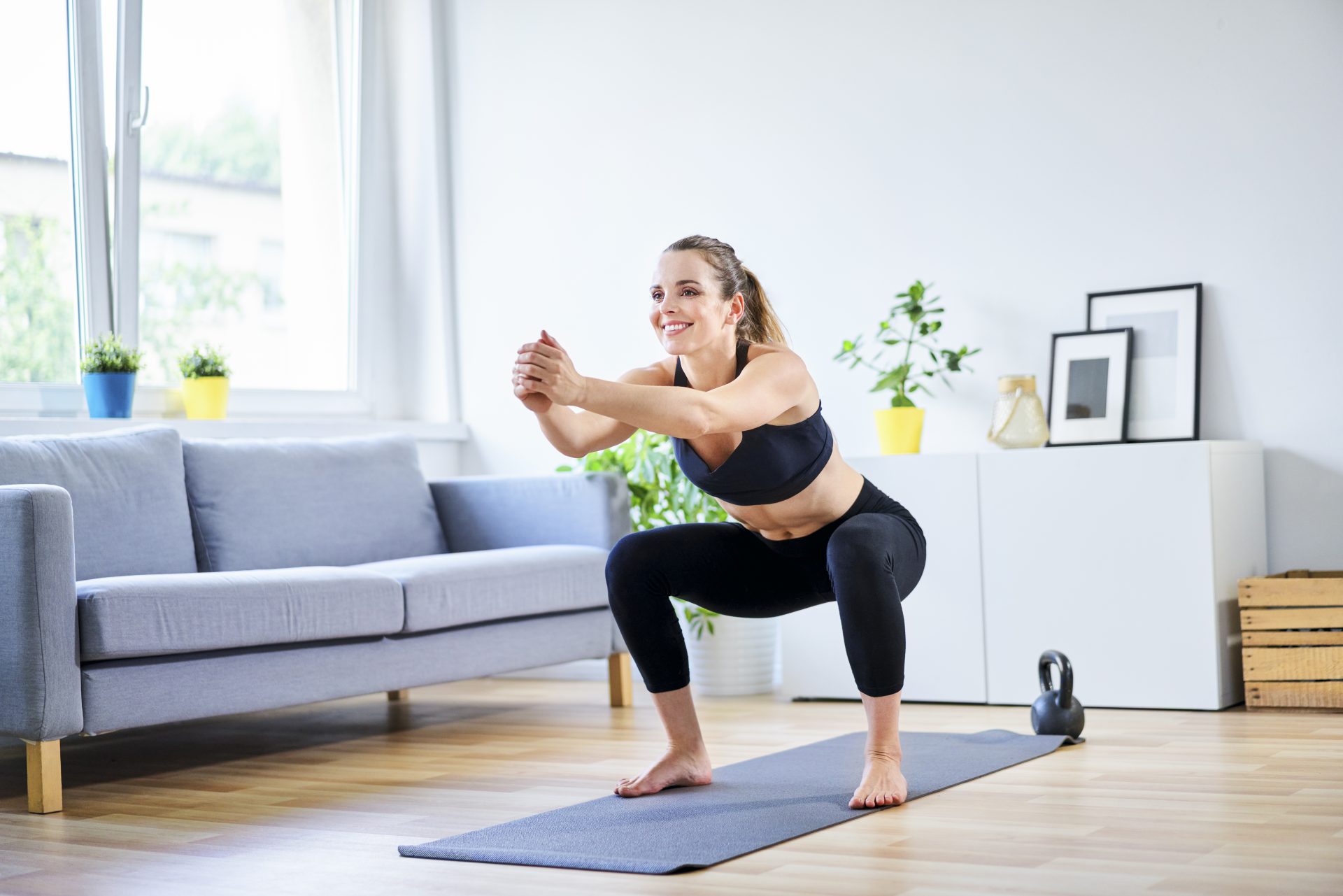
Sabri points out that you’re also working on your core strength when you perform a squat hold: “If you’re squatting correctly, you’re engaging your core and back muscles. This will help build abdominal endurance and improve your balance and posture.”
As the core is the epicentre of all movements and our main stabiliser, says Sabri, doing regular squat holds could also benefit your performance in the gym and in other sports such as running and swimming.
What’s more, because a squat hold is a low impact, isometric (static) exercise, there’s less risk of injury compared with a dynamic, high impact move such as a jump squat. This means you can safely incorporate it into your training routine to develop muscular endurance without getting too fatigued for your more intense, weights-based training sessions.
You can also perform the exercise anywhere, you don’t need much space and there’s no equipment required. It’s ideal for when you can’t make it to the gym, you’re in a rush or away from home.
WHAT IS THE CORRECT WAY TO PERFORM A SQUAT HOLD?
I wanted to make sure my form was correct before I started the challenge, so I asked Sabri for some advice.
Here’s how to perform a squat hold properly:
- Stand with your feet shoulder-width apart and slightly turned outwards. Make sure you engage your core and set your shoulders.
- Raise your arms out at shoulder level or clasp your hands together in front of your chest.
- Slowly lower yourself into a squat position by bending at the knees and pushing the hips backwards. Lower yourself down until your thighs are parallel with the ground.
- Take a moment to look down at your knees and ensure that they are positioned over the middle of your toes and not buckling in or outwards.
- Engage your core, breath and hold it for as long as you can.
- When you’re ready to come out of the position, return to standing by dropping your arms and pushing your hips forward.
THE 14-DAY SQUAT HOLD CHALLENGE: WEEK 1
I wasn’t sure of the best way to progress from my sub-60 second squat hold time to five minutes in 14 days. Luckily, Arnold designed a fantastic two-week programme to help me achieve my goal.
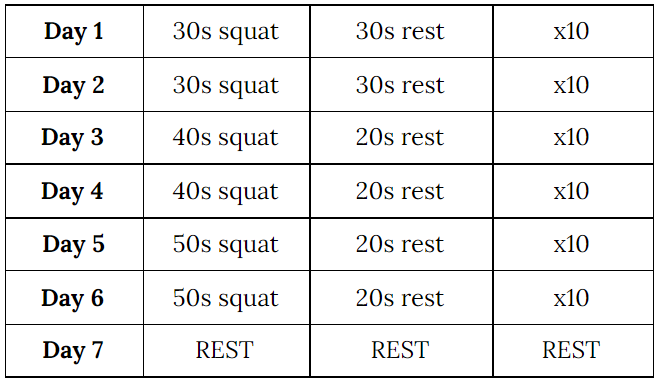
DAYS 1-2
As per Arnold’s suggestion, I kick off the challenge with a warm-up consisting of walking knee hugs, side shuffles, arm circles and walking lunges.
According to Madigan, working on my ankle, hip and back mobility is key if I want to make sure my form is correct and I don’t get injured, so I follow her advice and do a few mobility drills including knee rocks, the cat-cow stretch, leg swings and my old favourite, the wall sit.
Now, it’s time to get started and thankfully, Arnold is easing me in gently. Today’s challenge consists of 10 30-second squat holds, with a 30-second rest period in between.
I find sitting in a squat for 30 seconds relatively easy to begin with but as I get through the sets, I definitely start to feel it in my legs and my glutes. It burns, but in a good way.
Arnold says it’s important to cool down, so afterwards, I perform a few exercises stretching out my quads, calves and hamstrings. I’m usually a bit lazy with cooling down but I’m sure my body will thank me tomorrow.
Day two is the same as day one so I’m not too nervous today. In fact, I realise I’m quite looking forward to my lunchtime squat hold session. Like day one, it doesn’t feel too challenging and I kind of enjoy the pain. I’m excited to see how I progress as the challenge goes on.
DAYS 3-4
We’re upping the ante slightly for the next couple of days as I have to perform 10 40-second squat holds with just 20 seconds of rest in between.
It definitely feels more challenging, particularly with the shorter rest period. By the last three sets, my legs are quivering. I’m still finding it fun, though, which is great! I blare some motivating music and sit through the five minutes of pain.
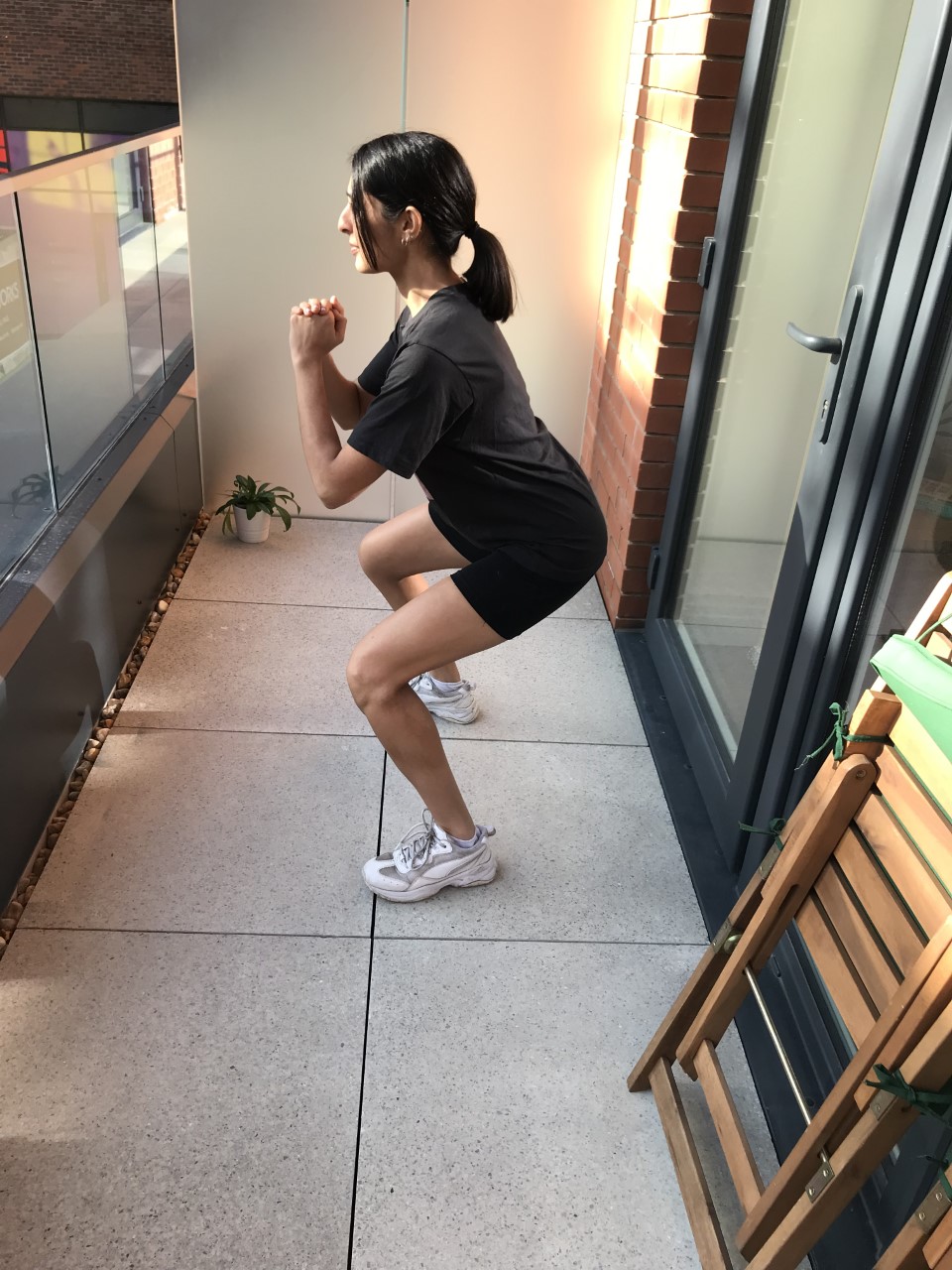
Since starting the challenge, I’ve been super busy with work and life so I haven’t had much chance to exercise as I usually would. I need to change this pronto. “Setting aside 30 to 50 minutes a day to work your strength, mobility and mechanics is crucial if you want to achieve a five-minute hold,” says Pisani.
With that in mind, on day four, I do a lower body workout which includes goblet squats, heel elevated squats and sumo squats, with a few plank variations thrown in to work on my core strength. I finish off the session with some of the back mobility drills Madigan suggested as I sometimes feel a bit of tension in my lower back when I squat.
DAYS 5-7
Days five and six are painful, to say the least. I have to do 10 sets of 50-second holds with a 20-second rest period in between. This feels significantly harder than the previous days.
On day five, I only manage eight sets before I have to give up. 50 seconds feels like an eternity while the rest period flies by. I’m in serious pain as I get to the last few sets and as much as I want to push myself, I don’t want to overdo it. On day six, I manage 10, although my squat isn’t very deep for the last few sets.
“Making sure you have adequate rest and recovery is important to avoid injury,” says Madigan. “Squat holds can be challenging on the lower body when performed for extended periods of time so go easy on yourself, and make sure you’re eating nutritious food, drinking lots of water and sleeping well.”
Day seven is a rest day and I’m so grateful. My quads and hamstrings feel sore when I wake up and my period arrives today so squatting is the very last thing I feel like doing. I end up, reluctantly, taking an extra rest day but I know my body needs it.
THE 14-DAY SQUAT HOLD CHALLENGE: WEEK 2
After two days off, I’m ready and raring to go. But when I see what Arnold has in store for this week, I feel less enthusiastic…
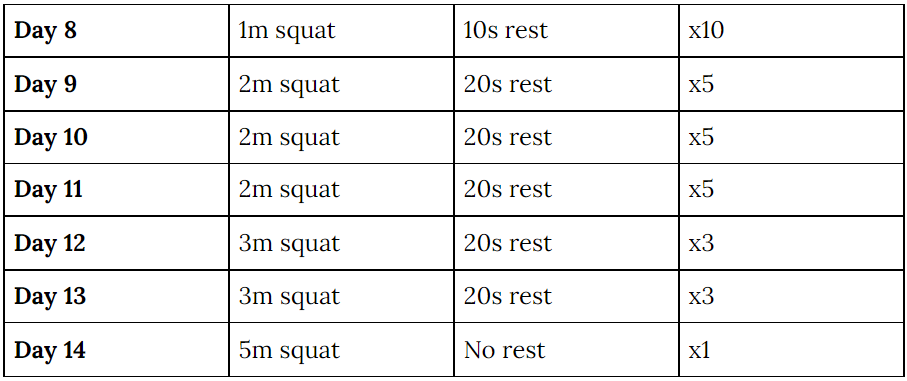
DAYS 8-9
I take back what I said before – this challenge isn’t fun, it’s brutal!
On day eight, I foolishly do my squat holds right after a tough lower body session so I find it really hard. I only manage to get through five sets of minute-long squat holds rather than 10 but as that adds up to five minutes in total, I deem it acceptable.
On day nine, I mix things up and do my squat holds first thing in the morning which I find works well as I’m feeling optimistic and energised after a good night’s sleep. After my warm-up and a few mobility drills, I sink into my squat and manage eight sets of one minute with 20 seconds of rest in between.
No exaggeration, it’s one of the most painful things I’ve endured in a long time. By the last couple of sets, my face is screwed up and I’m actually grunting in pain. It’s not a pretty sight!
DAYS 10-13
Over the next few days, it’s more of the same (pain, grunting and ugly faces) as I progress from five sets of two-minute holds to three sets of three-minute holds.
I only do three sets of two-minutes holds and I have to extend the rest period to 30 seconds when I get to three minutes but I don’t think that’s too bad.
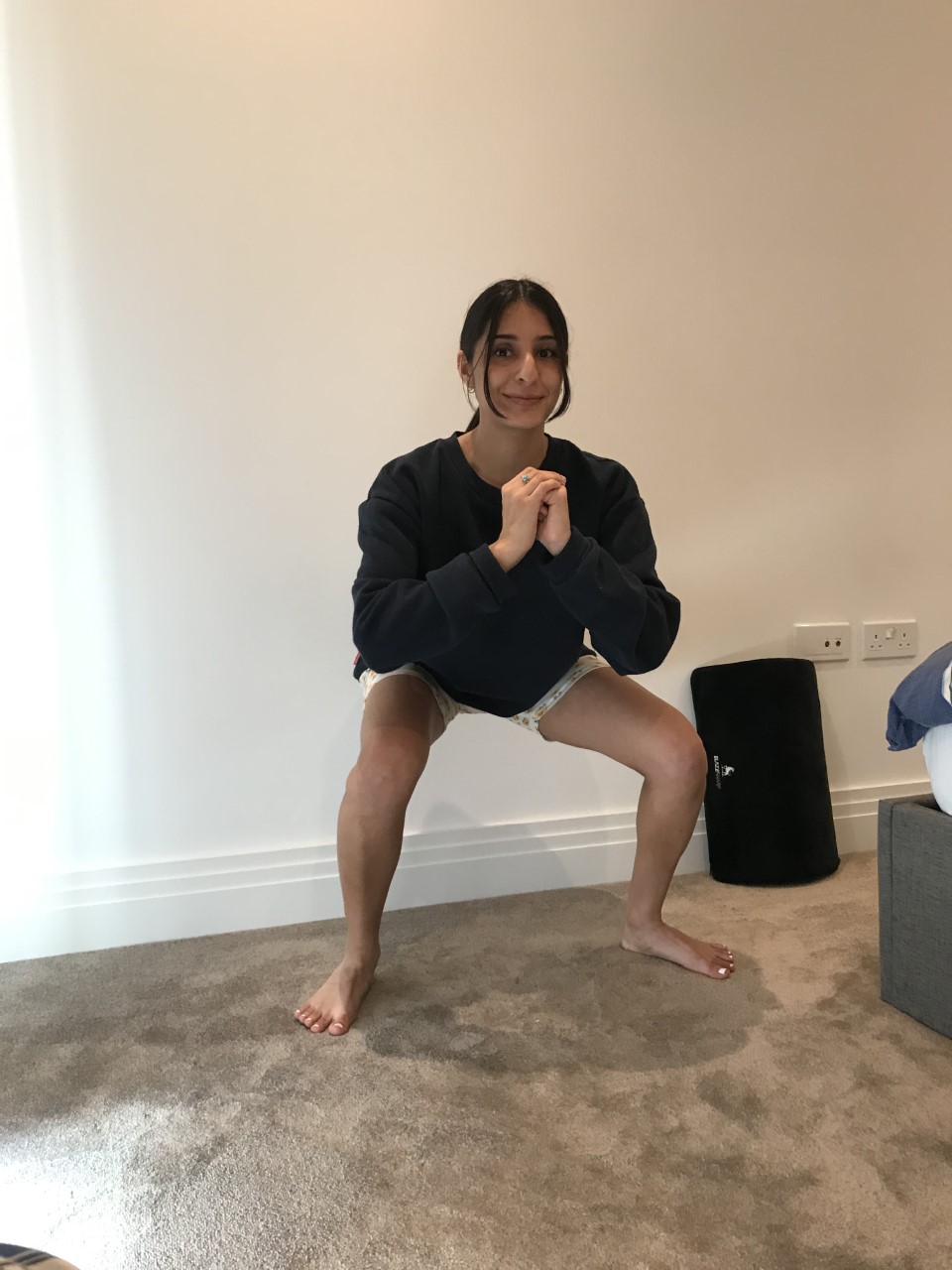
As I reflect on the challenge so far, I realise that it hasn’t just been physically demanding, it’s been a huge mental challenge too. Enduring the discomfort and pushing through is hard, but it’s also extremely rewarding and I do feel great afterwards.
During the last few days of the challenge, I make sure to set aside at least 30 minutes each day to work on my lower body and core strength as I know this is super important if I’m going to succeed. Unfortunately, I don’t have access to weights as I’m staying at my parents’ house for a few days, so I do a series of bodyweight workouts on the Fiit app. Fingers crossed they do the trick!
DAY 14
Today’s the big day and it’s safe to say I’m terrified. I decide it’s best to get it done first thing, so after chowing down on a hearty bowl of porridge and downing a strong coffee, I get started.
You may also like
Fitness challenge: “I held a plank every day for a month – this is what happened”
I spend at least 10 minutes warming up and then I faff about choosing the right songs to see me through before I finally hit the start button on my timer.
The first minute is bearable and the second is painful but I remain in position. I keep glancing at the timer and can feel myself getting anxious so I try to calm myself down with some positive affirmations.
At three minutes, I’m over halfway and I can see the light at the end of the tunnel. I can keep going for another two minutes, right?!
Unfortunately, I can’t. My legs are literally shaking, the burn is like nothing I’ve ever experienced and my lower back is in pain so four minutes and 20 seconds in, I collapse onto my bedroom floor. And just like that, the challenge is over.
The verdict
If I’d have known how difficult it was going to be, I’m not sure I would have said yes to the challenge, but I’m so glad I did.
Okay, so I didn’t quite make it to five minutes in 14 days but I’m still incredibly proud of myself. Holding a squat for over four minutes is a massive achievement and something I certainly wouldn’t have been able to do a few weeks earlier.
As someone who struggles with progress when it comes to building muscle, partly because I set mental limits on what I’m capable of, this challenge has been fantastic for me. I usually stick with the same weights week in, week out but this has taught me that I can accomplish more than I think, if I just push myself a little.
I’m certainly feeling stronger, particularly in my quads and glutes. Since completing the challenge, I’ve been slowly upping the weight on my lower body exercises and it feels great.
I’m also pleased because I’ve developed a good routine of warming up, cooling down and working on my mobility. As mentioned, I’ve never been very good at this but I realise that putting in the effort does make a difference, I’m determined to keep this up.
Would I recommend the challenge? Yes, absolutely, but only if you’re willing to put in the work. It requires significant time, effort and dedication. I wouldn’t suggest embarking on it unless you can fully commit.
Squat hold variations
Squat holds for beginners
To make things slightly easier, Pisani advises limiting your range of motion. “As much as we’d all love to settle into a beautiful deep squat from the start, unless you’ve been training for years, this probably isn’t your reality.”
The most important thing is to focus on proper form when performing your squat, he says. “You don’t have to go down as far, just make sure your muscles are engaged and working hard throughout.”
If you’re a complete beginner, Madigan suggests starting off with wall sits. “You need to be able to master this before you move on to a squat hold,” she says. “Doing this will help you to build strength in your lower body and improve your lower back mobility so you’re better prepared for squat holds.”
Sabri also suggests using a chair to help you balance and master your form. “Place the chair in front of you and gently rest your hand on it for some extra support,” she explains.
“When you’re ready to come out of the position, use the chair for some support but make sure your legs are doing the majority of the work and your core is engaged,” she continues.
UPPING THE INTENSITY
If you’re able to get to the five-minute mark and feel you’ve got more to give, here are some ways to make things more challenging:
- Try adding extra load – you could use a dumbbell, a kettlebell, a sandbag or even a water bottle.
- If you want to work your upper body at the same time, Sabri suggests holding a pair of dumbbells out in front of you.
- You can also extend the time. If five minutes doesn’t feel challenging anymore, push your limits and see how long you can hold a squat.
For more equipment-free fitness challenges, check out the Strong Women Training Club library.
Images: author’s own
Source: Read Full Article